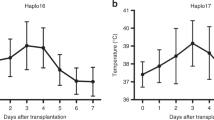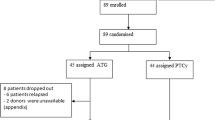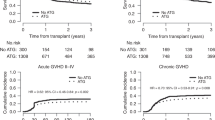Abstract
Conditioning regimens are an important issue determining the outcome of hematopoietic stem cell transplantation (HSCT). Less toxicity, early engraftment and no relapse are the aims of efficient conditioning. Our objective was to investigate the long-term effects of BU–CY and their administration order on the toxicity and chimerism in a mouse model of HSCT. Female BALB/c mice were treated with either BU (15 mg/kg/day × 4)–CY (100 mg/kg/day × 2) or CY–BU. Treated mice were transplanted with Sca-1+ cells from male BALB/c mice. Until 90 days after HSCT, the animals were monitored for body weight and analyzed for cellular phenotype of the thymus, spleen and BM, total chimerism, the spleen chimerism of DCs and T regulatory (Treg) cells, and hepatotoxicity. BU–CY and CY–BU treatments exerted comparable myeloablative and immunosuppressive effects. The long-term engraftment of donor cells in the BM and thymus regeneration showed the same features in both groups. However, the two regimens differed; in general, hepatotoxicity and chimerism of DC and Treg cells. In the long term, BU–CY, but not CY–BU caused a marked decrease in body weight and a significant increase in the activities of the liver enzymes, particularly aspartate amino transferase (AST). We conclude that the alteration of the administration order of BU–CY to CY–BU not only gives the same level of engraftment but also reduces the toxicity of the conditioning regimen that might be valuable specially in young patients who are undergoing HSCT.
This is a preview of subscription content, access via your institution
Access options
Subscribe to this journal
Receive 12 print issues and online access
$259.00 per year
only $21.58 per issue
Buy this article
- Purchase on Springer Link
- Instant access to full article PDF
Prices may be subject to local taxes which are calculated during checkout





Similar content being viewed by others
References
Storb R . Allogeneic hematopoietic stem cell transplantation—yesterday, today, and tomorrow. Exp Hematol 2003; 31: 1–10.
Burt RK, Barr W, Oyama Y, Traynor A, Slavin S . Future strategies in hematopoietic stem cell transplantation for rheumatoid arthritis. J Rheumatol Suppl 2001; 64: 42–48.
Little MT, Storb R . History of haematopoietic stem-cell transplantation. Nat Rev Cancer 2002; 2: 231–238.
Vriesendorp HM . Aims of conditioning. Exp Hematol 2003; 31: 844–854.
Tutschka PJ, Santos GW . Bone marrow transplantation in the busulfan-treated rat. I. Effect of cyclophosphamide and rabbit antirat thymocyte serum as immunosuppression. Transplantation 1975; 20: 101–106.
Mengarelli A, Iori A, Guglielmi C, Romano A, Cerretti R, Torromeo C et al. Standard versus alternative myeloablative conditioning regimens in allogeneic hematopoietic stem cell transplantation for high-risk acute leukemia. Haematologica 2002; 87: 52–58.
Clift RA, Buckner CD, Thomas ED, Bensinger WI, Bowden R, Bryant E et al. Marrow transplantation for chronic myeloid leukemia: a randomized study comparing cyclophosphamide and total body irradiation with busulfan and cyclophosphamide. Blood 1994; 84: 2036–2043.
Michel G, Gluckman E, Esperou-Bourdeau H, Reiffers J, Pico JL, Bordigoni P et al. Allogeneic bone marrow transplantation for children with acute myeloblastic leukemia in first complete remission: impact of conditioning regimen without total-body irradiation—a report from the Societe Francaise de Greffe de Moelle. J Clin Oncol 1994; 12: 1217–1222.
Davies SM, Ramsay NK, Klein JP, Weisdorf DJ, Bolwell B, Cahn JY et al. Comparison of preparative regimens in transplants for children with acute lymphoblastic leukemia. J Clin Oncol 2000; 18: 340–347.
Ringden O, Ruutu T, Remberger M, Nikoskelainen J, Volin L, Vindelov L et al. A randomized trial comparing busulfan with total body irradiation as conditioning in allogeneic marrow transplant recipients with leukemia: a report from the Nordic Bone Marrow Transplantation Group. Blood 1994; 83: 2723–2730.
Down JD, Tarbell NJ, Thames HD, Mauch PM . Syngeneic and allogeneic bone marrow engraftment after total body irradiation: dependence on dose, dose rate, and fractionation. Blood 1991; 77: 661–669.
Guest I, Uetrecht J . Drugs toxic to the bone marrow that target the stromal cells. Immunopharmacology 2000; 46: 103–112.
de Jonge ME, Huitema AD, Rodenhuis S, Beijnen JH . Clinical pharmacokinetics of cyclophosphamide. Clin Pharmacokinet 2005; 44: 1135–1164.
Ringden O, Remberger M, Ruutu T, Nikoskelainen J, Volin L, Vindelov L et al. Increased risk of chronic graft-versus-host disease, obstructive bronchiolitis, and alopecia with busulfan versus total body irradiation: long-term results of a randomized trial in allogeneic marrow recipients with leukemia. Nordic Bone Marrow Transplantation Group. Blood 1999; 93: 2196–2201.
Toubert ME, Socie G, Gluckman E, Aractingi S, Esperou H, Devergie A et al. Short- and long-term follow-up of thyroid dysfunction after allogeneic bone marrow transplantation without the use of preparative total body irradiation. Br J Haematol 1997; 98: 453–457.
Benyunes MC, Sullivan KM, Deeg HJ, Mori M, Meyer W, Fisher L et al. Cataracts after bone marrow transplantation: long-term follow-up of adults treated with fractionated total body irradiation. Int J Radiat Oncol Biol Phys 1995; 32: 661–670.
Vassal G, Hartmann O, Benhamou E . Busulfan and veno-occlusive disease of the liver. Ann Intern Med 1990; 112: 881.
Yoshihara S, Tateishi U, Ando T, Kunitoh H, Suyama H, Onishi Y et al. Lower incidence of Bronchiolitis obliterans in allogeneic hematopoietic stem cell transplantation with reduced-intensity conditioning compared with myeloablative conditioning. Bone Marrow Transplant 2005; 35: 1195–1200.
Giraud G, Bogdanovic G, Priftakis P, Remberger M, Svahn BM, Barkholt L et al. The incidence of hemorrhagic cystitis and BK-viruria in allogeneic hematopoietic stem cell recipients according to intensity of the conditioning regimen. Haematologica 2006; 91: 401–404.
Claessens JJ, Beerendonk CC, Schattenberg AV . Quality of life, reproduction and sexuality after stem cell transplantation with partially T-cell-depleted grafts and after conditioning with a regimen including total body irradiation. Bone Marrow Transplant 2006; 37: 831–836.
Ferry C, Socie G . Busulfan–cyclophosphamide versus total body irradiation–cyclophosphamide as preparative regimen before allogeneic hematopoietic stem cell transplantation for acute myeloid leukemia: what have we learned? Exp Hematol 2003; 31: 1182–1186.
Nilsson C, Forsman J, Hassan Z, Abedi-Valugerdi M, O'Connor C, Concha H et al. Effect of altering administration order of busulphan and cyclophosphamide on the myeloablative and immunosuppressive properties of the conditioning regimen in mice. Exp Hematol 2005; 33: 380–387.
Hassan Z, Nilsson C, Hassan M . Liposomal busulphan: bioavailability and effect on bone marrow in mice. Bone Marrow Transplant 1998; 22: 913–918.
Weber-Matthiesen K, Winkemann M, Muller-Hermelink A, Schlegelberger B, Grote W . Simultaneous fluorescence immunophenotyping and interphase cytogenetics: a contribution to the characterization of tumor cells. J Histochem Cytochem 1992; 40: 171–175.
Weber-Matthiesen K, Deerberg J, Poetsch M, Grote W, Schlegelberger B . Numerical chromosome aberrations are present within the CD30+ Hodgkin and Reed–Sternberg cells in 100% of analyzed cases of Hodgkin's disease. Blood 1995; 86: 1464–1468.
Dunn CD . The chemical and biological properties of busulphan (‘Myleran’). Exp Hematol 1974; 2: 101–117.
Westerhof GR, Ploemacher RE, Boudewijn A, Blokland I, Dillingh JH, McGown AT et al. Comparison of different busulfan analogues for depletion of hematopoietic stem cells and promotion of donor-type chimerism in murine bone marrow transplant recipients. Cancer Res 2000; 60: 5470–5478.
Santos GW, Tutschka PJ, Brookmeyer R, Saral R, Beschorner WE, Bias WB et al. Marrow transplantation for acute nonlymphocytic leukemia after treatment with busulfan and cyclophosphamide. N Engl J Med 1983; 309: 1347–1353.
Parkman R, Rappeport JM, Hellman S, Lipton J, Smith B, Geha R et al. Busulfan and total body irradiation as antihematopoietic stem cell agents in the preparation of patients with congenital bone marrow disorders for allogenic bone marrow transplantation. Blood 1984; 64: 852–857.
Mitsuyasu RT, Champlin RE, Gale RP, Ho WG, Lenarsky C, Winston D et al. Treatment of donor bone marrow with monoclonal anti-T-cell antibody and complement for the prevention of graft-versus-host disease. A prospective, randomized, double-blind trial. Ann Intern Med 1986; 105: 20–26.
Hanash AM, Levy RB . Donor CD4+CD25+ T cells promote engraftment and tolerance following MHC-mismatched hematopoietic cell transplantation. Blood 2005; 105: 1828–1836.
Hoffmann P, Ermann J, Edinger M, Fathman CG, Strober S . Donor-type CD4(+)CD25(+) regulatory T cells suppress lethal acute graft-versus-host disease after allogeneic bone marrow transplantation. J Exp Med 2002; 196: 389–399.
Matte CC, Liu J, Cormier J, Anderson BE, Athanasiadis I, Jain D et al. Donor APCs are required for maximal GVHD but not for GVL. Nat Med 2004; 10: 987–992.
Dix SP, Wingard JR, Mullins RE, Jerkunica I, Davidson TG, Gilmore CE et al. Association of busulfan area under the curve with veno-occlusive disease following BMT. Bone Marrow Transplant 1996; 17: 225–230.
McDonald GB, Slattery JT, Bouvier ME, Ren S, Batchelder AL, Kalhorn TF et al. Cyclophosphamide metabolism, liver toxicity, and mortality following hematopoietic stem cell transplantation. Blood 2003; 101: 2043–2048.
DeLeve LD . Cellular target of cyclophosphamide toxicity in the murine liver: role of glutathione and site of metabolic activation. Hepatology 1996; 24: 830–837.
Deeg HJ, Storer B, Slattery JT, Anasetti C, Doney KC, Hansen JA et al. Conditioning with targeted busulfan and cyclophosphamide for hemopoietic stem cell transplantation from related and unrelated donors in patients with myelodysplastic syndrome. Blood 2002; 100: 1201–1207.
McCune JS, Batchelder A, Deeg HJ, Gooley T, Cole S, Phillips B et al. Cyclophosphamide following targeted oral busulfan as conditioning for hematopoietic cell transplantation: pharmacokinetics, liver toxicity, and mortality. Biol Blood Marrow Transplant 2007; 13: 853–862.
Bushhouse S, Ramsay NK, Pescovitz OH, Kim T, Robison LL . Growth in children following irradiation for bone marrow transplantation. Am J Pediatr Hematol Oncol 1989; 11: 134–140.
Millar JL, Hudspith BN, Blackett NM . Reduced lethality in mice receiving a combined dose of cyclophosphamide and busulphan. Br J Cancer 1975; 32: 193–198.
Millar JL, McElwain TJ . Combinations of cytotoxic agents that have less than expected toxicity on normal tissues in mice. Antibiot Chemother 1978; 23: 271–282.
Bomberger C, Singh-Jairam M, Rodey G, Guerriero A, Yeager AM, Fleming WH et al. Lymphoid reconstitution after autologous PBSC transplantation with FACS-sorted CD34+ hematopoietic progenitors. Blood 1998; 91: 2588–2600.
Weinberg K, Annett G, Kashyap A, Lenarsky C, Forman SJ, Parkman R . The effect of thymic function on immunocompetence following bone marrow transplantation. Biol Blood Marrow Transplant 1995; 1: 18–23.
Storek J, Witherspoon RP, Storb R . T cell reconstitution after bone marrow transplantation into adult patients does not resemble T cell development in early life. Bone Marrow Transplant 1995; 16: 413–425.
Hassan M, Ljungman P, Ringden O, Hassan Z, Oberg G, Nilsson C et al. The effect of busulphan on the pharmacokinetics of cyclophosphamide and its 4-hydroxy metabolite: time interval influence on therapeutic efficacy and therapy-related toxicity. Bone Marrow Transplant 2000; 25: 915–924.
Acknowledgements
This study was supported by grants from the Swedish Cancer Foundation and the Swedish Children Cancer Society.
Author information
Authors and Affiliations
Corresponding author
Rights and permissions
About this article
Cite this article
Sadeghi, B., Jansson, M., Hassan, Z. et al. The effect of administration order of BU and CY on engraftment and toxicity in HSCT mouse model. Bone Marrow Transplant 41, 895–904 (2008). https://doi.org/10.1038/sj.bmt.1705996
Received:
Revised:
Accepted:
Published:
Issue Date:
DOI: https://doi.org/10.1038/sj.bmt.1705996
Keywords
This article is cited by
-
Effects of Chemotherapy on Neuroinflammation, Neuronal Damage, Neurogenesis, and Behavioral Performance in Bone Marrow Transplantation Recipient Mice
Neurotoxicity Research (2022)
-
Busulfan-cyclophosphamide versus cyclophosphamide-busulfan as conditioning regimen before allogeneic hematopoietic cell transplantation: a prospective randomized trial
Annals of Hematology (2021)
-
Priming mobilization of hair follicle stem cells triggers permanent loss of regeneration after alkylating chemotherapy
Nature Communications (2019)
-
The effect of N-acetyl-l-cysteine (NAC) on liver toxicity and clinical outcome after hematopoietic stem cell transplantation
Scientific Reports (2018)
-
Busulfan–Melphalan followed by autologous stem cell transplantation in patients with high-risk neuroblastoma or Ewing sarcoma: an exposed–unexposed study evaluating the clinical impact of the order of drug administration
Bone Marrow Transplantation (2016)



